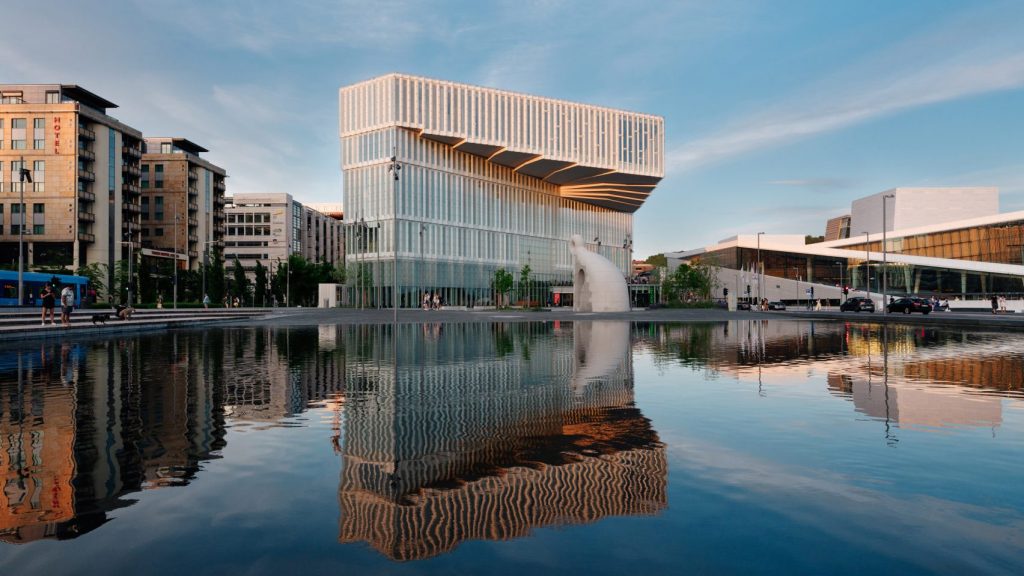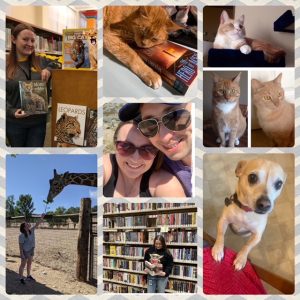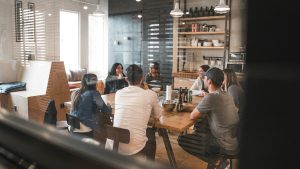I made an infographic of my five key takeaways from this course. It’s been a fun ride!
Author: Sara Martinez
Here is a link to my inspiration report about bringing podcasting to my library system! This is from my executive summary:
As a library system, it’s important to look at the trends and think of fresh ideas to connect with our patrons.
An example of this is implementing a district-wide podcast that will allow for patron input of what they
would like to hear. A successful podcast can lead to many more library users through our promoting and
word-of-mouth. There are pros and cons to this method, but this report will describe the immeasurable
benefits and opportunities a podcast can provide for our libraries and, more importantly, our
communities.
In the infinite learning module, I appreciated reading the article titled Emotional Labor, Stressors, and Librarians Who Work with the Public (2020). I’ve worked in customer service jobs for most of my adult life, so that type of work is not new to me. However, a coworker and I were talking the other day about feeling more burnout lately. I know that part of it for me is school on top of working full time, but said coworker is not in school anymore and is also feeling the burnout. We describe it as having to be “on” all the time. Being in customer service mode almost every day is emotionally taxing, even if I do enjoy the job. The article also mentions short staffing which does seem to usually be a problem in my jobs, as well. An important part of self-care for librarians is using personal, vacation, and sick time. When libraries are short staffed, it can be hard to feel like it’s okay to take time off. I like to keep in mind that taking some time off (not at the last minute) helps me recharge and I’m much more productive when I get back to work.
I also found this article in which library workers recalled specific negative instances with patrons and how they perform self-care. I found the article relatable and insightful. It’s titled The Emotional Labour of Public Library Work (2021).
Before this course, I had heard of Human Libraries, but I never stopped to think WHY stories are important in libraries. I can now see a few reasons why Human Libraries would be a great addition to public libraries.
The articles provided in the course opened my eyes to the impact this program can have. This was especially evident in the article, New Study on the Impact of the Human Library. “Readers” from a Human Library event were interviewed three months after the event. The findings showed that Readers remembered exact details about the event. This retention shows the impact it had on them. They are now able to be more aware of their own biases and look at the world with an open mind to the diversity it holds. Most importantly, they realized that action is necessary for change to be made and some of the participants have begun making changes within themselves.
I love the idea of the Human Library because it’s something that many people can do. Some people have specific topics they might want to share their experiences with (LGBTQ+, disabilities, etc.). However, I believe almost anyone can sign up to be a Book. Everyone has a different story to tell, whether they are aware of it or not. I’m envisioning ways to open up this idea and make it broader. For example, some libraries have ESL chat sessions where people can practice their English by having conversations with other people practicing the language. I can see this format being applied to Human Libraries. There are many Books walking around and Readers can roam the room and have conversations about their life experiences. I’m imagining an informal setting of meandering where the Books are anyone who wants to share about themselves. A program like this can also be good for our lonely patrons who like to come up to the desk and talk for long periods of time. Some of them have really fascinating stories, but we don’t always have time at the reference desks to talk with them. Either way, I think the findings from the study are enough reason to incorporate more Human Libraries into our public libraries!

Photo by Jonathan Kemper on Unsplash
It’s important for libraries to look at new horizons and adapt, but I’ve always personally felt a little behind the times. I was one of the last people I knew to get a smart phone when they came out because I was “against” them. I was never interested in the newest tech. In my high school self’s opinion, the internet and smart phones were making people lazy, absent-minded, and gullible. I don’t feel as strongly now, and I know that I must stay knowledgeable on new trends to be a successful librarian. Seeing the articles about ChatGPT and libraries piqued my interest.
In the article Getting a Grip on ChatGPT (2023), the authors mention the slight panic when Wikipedia launched and that turned out to be a bit of an overreaction. ChatGPT might follow in the same footsteps. Eventually, it might be used so often that we don’t even think about it. But how can we use ChatGPT in the library setting? The article called ChatGPT: A Library Perspective (2023), says “the library is here to help you to learn and understand how these tools can be used and provide some guidance on when they should or should not be used according to our professional best practices.” This made me realize that having library programs related to best practices when using ChatGPT would be a great idea. This shows the public that libraries are current with the times and not shying away from new advancements, while also teaching people information literacy. Incorporating new tech in libraries isn’t inherently a bad thing. There are positives that can come out of it.
Two of my favorite things are libraries and animals. Aside from some libraries offering programs where children can read with dogs, animals and libraries don’t particularly mesh well together. This led me to think of a way in which libraries can help animals in need just like they help other members of the community. Follow the link below to see my idea for a monthly cat cafe adoption event at my local library.

Photography is by Einar Aslaksen.
Looking into global libraries makes me yearn for a trip around the world just to visit these beautiful and innovative spaces. One that stood out to me in my search was the Deichman Bjørvika, or Oslo Public Library, in Norway. The library is a massive, six-story building next to the Oslo fjord. The top floor provides nice views of the fjord. Not only are there thousands of books, but the library also houses a cinema, workshops, cafes, auditoriums, recording studios, and gaming rooms. It’s obvious the Oslo Public Library prides itself on being a community hub that people can enjoy for many reasons.
What stood out to me most was the Future Library art project. This century long project started in the year 2014 and collects one manuscript a year from 100 authors. The manuscripts are kept hidden away in the library and are not able to be read until 2114, at which time they will be printed and published. The forest already exists that contains the trees that will be used in the printing of the books. The Silent Room in the library (where the manuscripts are held) is made out of wood from the trees in the forest. I think this is a fascinating way for the library to start collecting material for the future and to ensure the works of these authors are being read and discussed many years from now. Katie Paterson, the artist of this project, says it “has nature, the environment at its core – and involves ecology, the interconnectedness of things, those living now and still to come.” The Future Library is living, breathing art.
References:
https://www.futurelibrary.no/#/
https://www.visitnorway.com/listings/deichman-bj%C3%B8rvika-oslo-public-library-main-branch/224381/

Photo by Yael Gonzalez on Unsplash
The library I work in is located in an underserved and low-income community. We have 3rd, 4th, and 5th grade class visits every week and many of these students don’t know their birthday, address, or how to spell their last name. Many of the parents of these kids don’t have the time or resources to bring their kids to the library. Class visits are a step in the right direction, but I’d like to examine what else libraries can do to give these students the best chance at success.
The IMLS Focus: Engaging Communities article (2015) states that 80% of low-income children can’t read by 3rd grade. The article focuses on the importance of partnerships being made throughout the community, not only to help with early learning, but to help with other basic needs. A lot of these kids also need food and clothing.
For one, libraries can determine which grades and/or schools aren’t taking advantage of class visits to the library and librarians can go directly to the schools and give students and teachers information on upcoming events at the library. The librarians can also put on a storytime for the kids. I would also like to see libraries bringing materials to the schools for the kids who can’t make it to the library. The teacher can collect the books they check out and the librarians can pick them up at their next visit to the school. The goal would be to get kids excited about reading by bringing library resources straight to them. This eliminates some barriers and creates more accessible services.
Long-term relationships between libraries, schools, and other organizations can give kids a better life now, and a better future.
References
Gonzalez, Y. (2019). [Green frog drawing]. Unsplash. https://unsplash.com/photos/green-frog-drawing-oV6RSDQlq8Q
Hill, C., Streams, S., Dooley, J., & Morris, L. (2015). IMLS focus: Engaging communities. Institute of Museum and Library Services. https://www.imls.gov/sites/default/files/whitepaper_convening3_final_9-2-2015_tagged.pdf
For assignment X, I’d like to explore a very divisive transition my library is currently going through and relate it to topics from class and outside readings. It’s clear that libraries must change with the times. This can mean changing the physical spaces of the library, having a stronger online presence, roaming librarians with moveable desks, etc. “Libraries for the people” is a concept that I feel many libraries are working towards, including the library system I work for.
Essentially, upper management in my library system has decided to implement a major re-haul of the children’s areas in all the libraries in the system. Small playgrounds, educational structures, and interactive activities are going to be installed. The goal is to teach families the importance of using play as a method of learning. This update will come at the cost of 50% of our collection. 50% of our material must be eliminated to make room for these changes. This decision has caused rifts between upper management and the employees who actually work in the libraries and want to keep our items available for our patrons. This upcoming change in our library spaces has piqued my interest in other libraries doing something similar. I’m hoping that looking into the great changes libraries are making will make me feel better about the loss of books at my library.
Libraries aren’t just buildings that house books anymore. Libraries today can now have tech centers, cafes, playgrounds, media centers, and more. Saskia Leferink (2018) points out, “the way a physical space meets the needs of individuals in specific user groups is key.” It’s important to have a space for everyone (quiet spaces, collaborative spaces, teen spaces…).
An article in Library Journal describes some of the fun and innovative ways libraries are using their spaces. A library in Texas is building a creativity space with a kitchen that will be open to the public even when the library is closed, a video production room, a train for kids to ride, a pretend restaurant, and a veterinary center (Pierce, 2021). The article also mentions libraries using mobile shelving and raised floors that can accommodate changes to the physical space and power distribution.
Redwood City Public Library opened up a makerspace in 2022 that includes 3D printers, modeling and design software, sewing machines, crafting tools, whiteboards, screen monitors, and reconfigurable tables and seating (Peninsula 360 Press, 2023).

The entrance to the Makerspace at Redwood City Public Library. Photo: P360P
When making big changes, it’s good to have transparency between all employees and invite those who don’t work directly in the library to visit the space. There should also be communication between everyone involved. According to Michael Casey and Michael Stephens (2007), “the transparent library’s fluid nature and open communication allow all levels of staff to understand what it takes to meet user needs.”
Ultimately, change in libraries is inevitable and should be for the best of the community. Teams should work together to transform libraries into what the community needs and work towards a common goal. This can mean having an open mind and trying new things. Here’s to the evolution of libraries!
References
Leferink, S. (2018, January 24). To keep people happy… keep some books. OCLC. https://blog.oclc.org/next/to-keep-people-happy-keep-some-books/
Peninsula 360 Press. (2023, May 7). Makerspace celebrates its first anniversary at the Redwood City Library. https://peninsula360press.com/en_us/makerspace-fulfills-its-first-anniversary/
Pierce, D. (2021, November 8). New library design: Spaces that connect, cultivate, and transform communities. Library Journal. https://www.libraryjournal.com/story/new-library-design-spaces-that-connect-cultivate-and-transform-communities
Stephens, M. & Casey, M. (2007, September 15). Going to the field. Tame the Web. https://tametheweb.com/2007/09/15/going-to-the-field/
Hi class!
My name is Sara and I have about one year left in the MLIS program. I’ve lived in the bay area my whole life, currently in San Jose, and work as a library assistant for the Santa Clara County Library District. I work in the children’s reference department and my goal is to become a children’s librarian. I’ve worked in public libraries for about 16 years in many different roles, both circulation and reference. I’m taking this class because I feel like I can learn a lot from it, and I’ve heard great things about it.
My hobbies include reading (currently Warbreaker by Brandon Sanderson), playing board games (my favorite at the moment is Arkham Horror), and traveling to new places. I’ve been really into sci-fi lately and am binging all of the Stargate shows and movies. I also enjoy spending time with my boyfriend and his dog, Buster, and my cat, Jack. I love animals and meeting a new doggo always makes my day. I’m looking forward to learning with you all this semester!


